We explore a view on how manufacturers are moving towards the use of RFID, for enhanced visibility throughout the supply chain in industrial applications owing to requirements to input more data about a given product
by Turck Australia
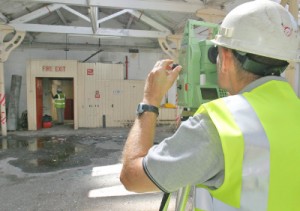 Industries are facing fierce market competition, making product consistency and customer satisfaction cornerstones of today’s industrial automation. Companies are striving for any competitive edge. To satisfy these initiatives, products must be verified to ensure the highest quality—from material verification and production to delivery. Consequently, today’s fast-paced manufacturing and processing environments rely on highly precise product identification, monitoring and tracking.
Industries are facing fierce market competition, making product consistency and customer satisfaction cornerstones of today’s industrial automation. Companies are striving for any competitive edge. To satisfy these initiatives, products must be verified to ensure the highest quality—from material verification and production to delivery. Consequently, today’s fast-paced manufacturing and processing environments rely on highly precise product identification, monitoring and tracking.
In the past, vision identification technologies, such as barcode/2D matrix were commonly used to monitor and track these processes, as well as store product information during production. However, due to the need to input more data about a given product, manufacturers are moving towards the use of a more sophisticated solution, radio frequency identification (RFID), for enhanced visibility throughout the chain of distribution.
Track and trace technologies are designed to quickly identify any issues or inconsistency early in production to promote customer retention and cost savings on inventory, labor and replacement products. In a comparison between RFID and vision identification technologies, describing the individual operating principles, assessing performance capabilities and identifying application suitability, with this knowledge, manufacturers can easily ascertain the ideal track and trace technology for their applications.
Technology comparison
Currently, two solutions/technologies rule the marketplace for industrial track and trace: barcode/2D matrix and radio frequency identification (RFID). Both are engineered for the same purpose, to deliver specific information about products as they move from incoming materials to the production line and finally through to distribution. Utilizing separate operating principles and tracking methods, RFID and barcode technologies each have their own distinct advantages and purposes.
Barcode
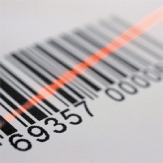 Barcode technology provides more of a legacy solution for product monitoring, and is an optical machine-readable representation of data that is physically attached to a product and stores information about that object. Originally, barcodes conveyed data by varying the widths and spacings of parallel lines, presented in linear or one-dimensional shapes—similar to what one sees on a retail product. In recent years, barcodes have evolved to include rectangles, dots, hexagons and other two-dimensional shapes for increased application compatibility and readability. However, barcodes are read only, therefore users cannot add to the information written on to the barcode as production continues.
Barcode technology provides more of a legacy solution for product monitoring, and is an optical machine-readable representation of data that is physically attached to a product and stores information about that object. Originally, barcodes conveyed data by varying the widths and spacings of parallel lines, presented in linear or one-dimensional shapes—similar to what one sees on a retail product. In recent years, barcodes have evolved to include rectangles, dots, hexagons and other two-dimensional shapes for increased application compatibility and readability. However, barcodes are read only, therefore users cannot add to the information written on to the barcode as production continues.
Though barcodes have progressed, they still face challenges that limit their suitability for many industrial applications. For instance, to obtain readings and access data, barcodes require line-of-sight with the reader, which means a product must be properly aligned in order for a barcode reader to identify the product by its code. In manufacturing environments, time is money, and if it takes several attempts to achieve proper alignment, it can be a time-consuming and costly process—impacting worker productivity and overall profitability.
Additionally, barcodes are not designed to provide the same inherent resilience and reusability that RFID tags offer. When used for industrial Works-in-Progress (WIP), barcodes lack the durability and consistency necessary to perform in demanding environments. The stickers can peel off, leaving a product devoid of any form of identification. Further, the ink can be smeared through rubbing or exposure to water or other elements, making the barcode illegible. Because of this, workers are often required to pause in their task to replace the barcode at each stage in the manufacturing process—ultimately reducing total operation efficiency.
Though barcodes are not ideal for all industrial and processing applications, they do provide the necessary performance capabilities required for commercial use. They are typically less expensive and simplistic, and they are a universal technology for commercial applications. For example, since barcodes contain two pieces of information, the product and the manufacturer, in retail, barcodes are used to provide inventory information for each product or object.
RFID
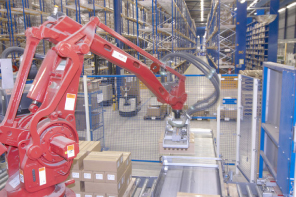 As an alternative to barcode, RFID offers a more sophisticated approach for track and trace applications. RFID is capable of intelligent, advanced data management that enhances product visibility throughout production and distribution. Further, since RFID enables users to both read and write information on the tag—even at diverse distances—RFID provides the capabilities and flexibility to accommodate a wider range of applications.
As an alternative to barcode, RFID offers a more sophisticated approach for track and trace applications. RFID is capable of intelligent, advanced data management that enhances product visibility throughout production and distribution. Further, since RFID enables users to both read and write information on the tag—even at diverse distances—RFID provides the capabilities and flexibility to accommodate a wider range of applications.
RFID systems contain three parts: the tag, transceiver and the interface. Tags can be active (uses a battery) or passive reflecting the signal back to the transceiver, which is often called a reader. The interface is the means of communicating the data from the tag to a screen or a data collection device such as a computer or a controller.
The transceiver is used to read the RFID tag, and an I/O device will communicate information on the tag with the enterprise or higher-level control system. RFID tags contain internal circuitry that respond to a radio frequency field that is provided by the transceiver. During operation, when the RFID tag passes through the field of the trans-ceiver, it detects the signal from the antenna. This activates the RFID tag, signalling it to transmit or receive information on its microchip.
Originally, this technology was developed as a method to remotely gather data through tags or transceivers. However, given their data storage capacity, manufacturers have been attaching or embedding these tags into an object during production and programming them with information about the product. By gathering more data through tags, RFID allows users to read and write data to the tag.
Performance versatility
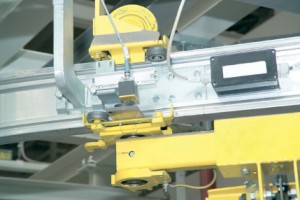 The versatility in performance capabilities offered with RFID enables this technology to be used in situations where barcodes or other optically read alternatives are impractical. Unlike conventional track and trace methods, RFID tags are not required to be placed on the surface of an object because they do not require line-of-sight to obtain an accurate reading. Instead, RFID tags can be embedded into the product, which still offers the desired reliability without being subjected to environmental elements. This protects them from wear and saves manufacturers significant replacement costs.
The versatility in performance capabilities offered with RFID enables this technology to be used in situations where barcodes or other optically read alternatives are impractical. Unlike conventional track and trace methods, RFID tags are not required to be placed on the surface of an object because they do not require line-of-sight to obtain an accurate reading. Instead, RFID tags can be embedded into the product, which still offers the desired reliability without being subjected to environmental elements. This protects them from wear and saves manufacturers significant replacement costs.
Additionally, RFID tags are offered in a wide range of sizes and come in virtually any housing style, and offer read and write abilities that can also be read from diverse distances.
In addition to its longevity and durability, RFID is also fast and accurate—increasing efficiency and productivity. The read time is typically less than 100 milliseconds, allowing large quantities of tags to be read at once rather than scanning item by item. Further, each tag contains a unique serial code, which allows a product to be scanned and tracked throughout the entire manufacturing process.
With its communication capabilities, RFID can provide real-time tracking to allow for maximum data availability and accessibility.
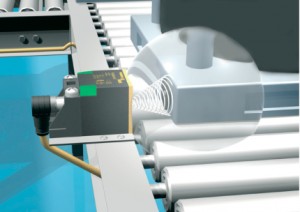 By integrating with common industrial networking protocols, such as PROFIBUS-DP, DeviceNe and Industrial Ethernet, RFID allows manufacturers to optimize data management. Additionally, RFID data carriers also provide a large quantity of read or write operations with high speeds, ultimately increasing tracking capabilities to improve operations. RFID offers increased memory storage over barcode options, with FRAM data carriers processing data up to ten times faster, enabling it to withstand more write operations, some even up to one billion cycles.
By integrating with common industrial networking protocols, such as PROFIBUS-DP, DeviceNe and Industrial Ethernet, RFID allows manufacturers to optimize data management. Additionally, RFID data carriers also provide a large quantity of read or write operations with high speeds, ultimately increasing tracking capabilities to improve operations. RFID offers increased memory storage over barcode options, with FRAM data carriers processing data up to ten times faster, enabling it to withstand more write operations, some even up to one billion cycles.
RFID’s ability to monitor materials so closely during production eliminates the risk of human error during production. By tracking one product through the entire manufacturing process, users can quickly identify if a component has skipped a stage. Further, storing detailed information about a given product prevents counterfeit materials from entering the stream of commerce. This advantage can be especially important in applications that directly impact the health and safety of consumers, such as food and pharmaceutical manufacturing. Plus, by ensuring consistent product quality, RFID can aid in preserving a busi-ness’s public impression and customer satisfaction.
While barcode technology offers a read-only solution, RFID can provide users with read and write flexibility. This allows information to be added/edited on the tag as it moves through production rather than having to include a new tag for each additional variable. Further, since read/ write tags can store more information, it enables faster processing, satisfying today’s high-speed applications.
Plus, since read/write tags can be completely erased and reused, they reduce equipment costs.
Applications
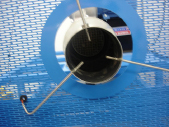 While RFID does offer advanced monitoring capabilities, it may not be ideal for all applications. Prior to implementing RFID into any manufacturing application, users should consider several aspects of the application to decide if RFID is the right solution for their needs.
While RFID does offer advanced monitoring capabilities, it may not be ideal for all applications. Prior to implementing RFID into any manufacturing application, users should consider several aspects of the application to decide if RFID is the right solution for their needs.
Manufacturers should always determine what data must be acquired from the product or component and how it will be used. For example, if product quality is needed, users should identify existing quality control systems and any issues that have been problematic. This helps determine where RFID should be applied, as well as helps measure RFID effectiveness and ROI after installation. Along with identifying what information must be ascertained, users should also consider the scope of the project and the scale of the plant. This will prevent the cost of an RFID solution from exceeding the value of the benefit it provides.
